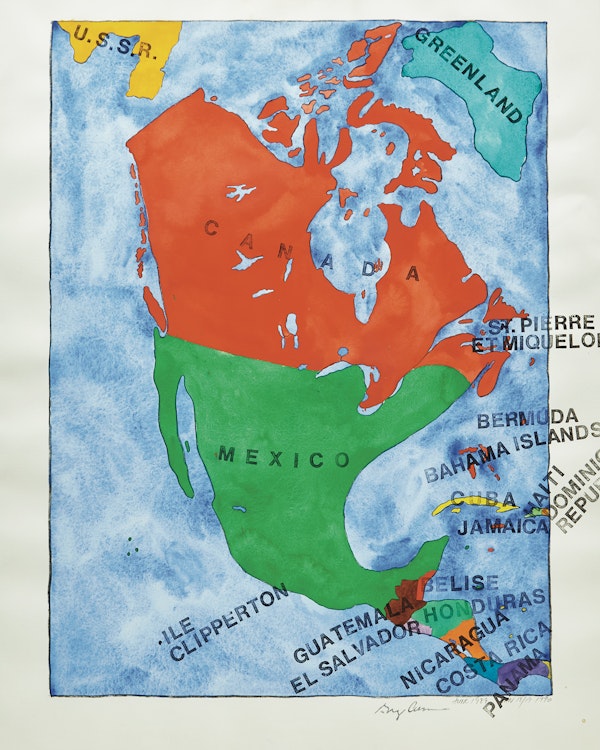Study for America by Gregory Richard Curnoe

Greg Curnoe
Study for America
watercolour
signed and dated “June 1989-January 18/19 1990” in the lower right margin; titled and dated to two labels on the reverse
28.5 x 22 ins ( 72.4 x 55.9 cms ) ( sheet )
Auction Estimate: $12,000.00 - $15,000.00
Price Realized $12,000.00
Sale date: June 8th 2023
Thielsen Galleries, London, Ontario
Private Collection, Toronto
Judith Rodger, “Greg Curnoe: Life and Work” [online publication], Art Canada Institute, Toronto, 2016, page 34
“Study for America” is an example of several map paintings that express Curnoe’s anti-Americanism. The map of North America eliminates the United States entirely; rather, the land is labeled as Mexico. To emphasize his belittling of the country, lesser-known destinations are mentioned, including Clipperton Island, an uninhabited coral reef in the Pacific Ocean.
Despite his own experiences and opinions on the United States, the artist’s map works were intended as tongue-in-cheek statements. Sheila Curnoe recalls her husband coming into their kitchen after he had successfully connected Mexico to the Canadian border: “He was so pleased with himself. He was laughing about it. It was meant to be funny and not to be taken so seriously.”
Share this item with your friends
Gregory Richard Curnoe
(1936 - 1992)
Born in London, Ontario in 1936, Greg Curnoe was a fervent regionalist visual artist and musician who championed the distinct voice of Canadian locales and London, Ontario, specifically. He attended Beal Technical School (1954-1956) and the Doon School of Art (1956) before attending the Ontario College of Art (1957-1960) then returned to London in 1960.
While still attending Beal Tech he became interested in Dada art and joined the Société Pour L’Etude Du Movement Dada since he himself became dedicated to attacking existing standards of the establishment bound by international styles of art. Taking the opposite pole, Curnoe freed himself from this concern by choosing his subjects immediately around him and rejoicing in a people’s art he encountered in everyday personal experiences.
One can find in his work the elements of constructivism, op art, pop art, dadaism and comic-strip-like marriage of words and pictures, a facet of art which has been his keen interest from his earliest years (his childhood ambition was to be a cartoonist). Curnoe’s work is drawn together by colours ranging from a brilliant carnival-like intensity to softer blends of browns, oranges, pinks, greens, etc.
In an article on Curnoe’s work in Saturday Night, Barry Hale in 1970 gave this description, “Curnoe’s paintings are as immediate in their impact as superlative, blown-up comic books; they are figurative, but not ‘realistic’ - the outlines (in general) are hard edged, there is no modelling, and large, brilliant colour areas collide and vibrate to achieve a hotly overwhelming whole. Like comics, they are printed all over the works, in various manners – words as labels, or self-contained statements like cartoon-balloons; they may surround the picture frame and lead off the right edge (like the narrative print of a cartoon strip), or simply exist in conjunction as a kind of concrete poetry – so , as well as their hot impact, Curnoe’s paintings have a McLuhanesque cool, they must be read, with all the self-involvement that reading implies.”
In addition to his painting, Curnoe was involved in many other fields, including nihilist politics, writing, film making, pop music and non music. In 1961 he began publishing the magazine “Region” with friends, as his commitment to regionalism intensified. They also opened the Region Gallery. He co-founded the Association for the Documentation of Neglected Aspects of Culture in Canada and co-founded the Canadian Artist’s Representation (a national association of Canadian artists growing in stature); the Nihilist Party of London, a good natured group of hecklers of establishment parties (all members with equal say, no leader). His work was first recognized by Ronald Bloore in 1961 when Bloore was a juror of a show and awarded Curnoe a prize.
Curnoe went on to represent Canada at the Venice Biennale in 1976 and had a retrospective at the Montreal Museum of Fine Arts in 1981, which then travelled across Canada. Though the artist’s work has influences of Abstract Expressionism, Pop Art and even musicality, Curnoe rooted his practice in the regional visual language of his native London and greater Canada. He is represented in the National Gallery of Canada, Vancouver Art Gallery, the Art Gallery of Ontario and the Montreal Museum of Fine Arts.
Sources: "A Dictionary of Canadian Artists, Volume I: A-F", compiled by Colin S. MacDonald, Canadian Paperbacks Publishing Ltd, Ottawa, 1977

